20 min to read
DIGITAL MARKETING VS TRADITIONAL MARKETING
As a business owner, you're constantly trying to find new and better ways to reach your target audience. You might wonder whether traditional or digital marketing is the better option for you.
In this post, we'll compare and contrast traditional and digital marketing, so you can decide which is the best option for your business.
Differences between digital marketing and traditional marketing
| Aspect | Traditional Marketing | Digital Marketing |
|---|---|---|
| Definition | Conventional modes like TV, radio, etc. | Internet, social media, SEO, etc. |
| Nature | Static campaigns | Dynamic and adaptable |
| Conversion | Slow conversion rates | Faster conversion rates |
| Engagement | Low engagement with the audience | High interactive engagement |
| ROI | Difficult to measure accurately | Measurable with analytics tools |
| Cost | Expensive | Cost-effective |
| Reach | Local reach | Global reach |
| Results | Delayed results and feedback | Real-time results and data |
| Communication | One-way communication | Two-way communication |
| Flexibility and Modification | Limited adjustments once launched | Easy modifications anytime |
| Brand Building | Historically effective | Credibility varies with content |
| Measurability and Analytics | Limited analytics | Robust analytics tools |
| Audience Segmentation | Limited segmentation capabilities | Personalized content for audiences |
| Interaction | Limited direct interaction | Facilitates direct engagement |
| Ad Skipping | Limited user choice | Users can skip ads if uninterested |
| Timing and Real-time Results | Slow campaign results | Quick and real-time results |
| Global Reach | Geographically limited | Breaks geographical barriers |
| Trust and Credibility | Often perceived as trustworthy | Credibility based on content, source |
Defining Digital Marketing and Traditional Marketing
So, what's the difference between traditional and digital marketing?
In essence, the main difference between both is simple. On the one hand, traditional marketing uses "conventional" mediums, such as TV, radio, magazines, newspaper ads and even cinema, to promote businesses or any service. Meanwhile, digital marketing uses digital technology mediums to spread publicity messages like e-mail marketing, social media, website pop-ups, search engines, mobile marketing and any other platform connected to the world wide web.
But digital marketing isn't as new as we thought because the term existed back in the '90s when the first web platform 1.0 came out. Although marketers didn't believe this would be a revolution, everything started to take flight when the first clickable banner appeared in 1993. Then, in 1994, Yahoo emerged as the new technology that would start moulding the search engines, with other competitors joining, like Alexa or Hotbot.
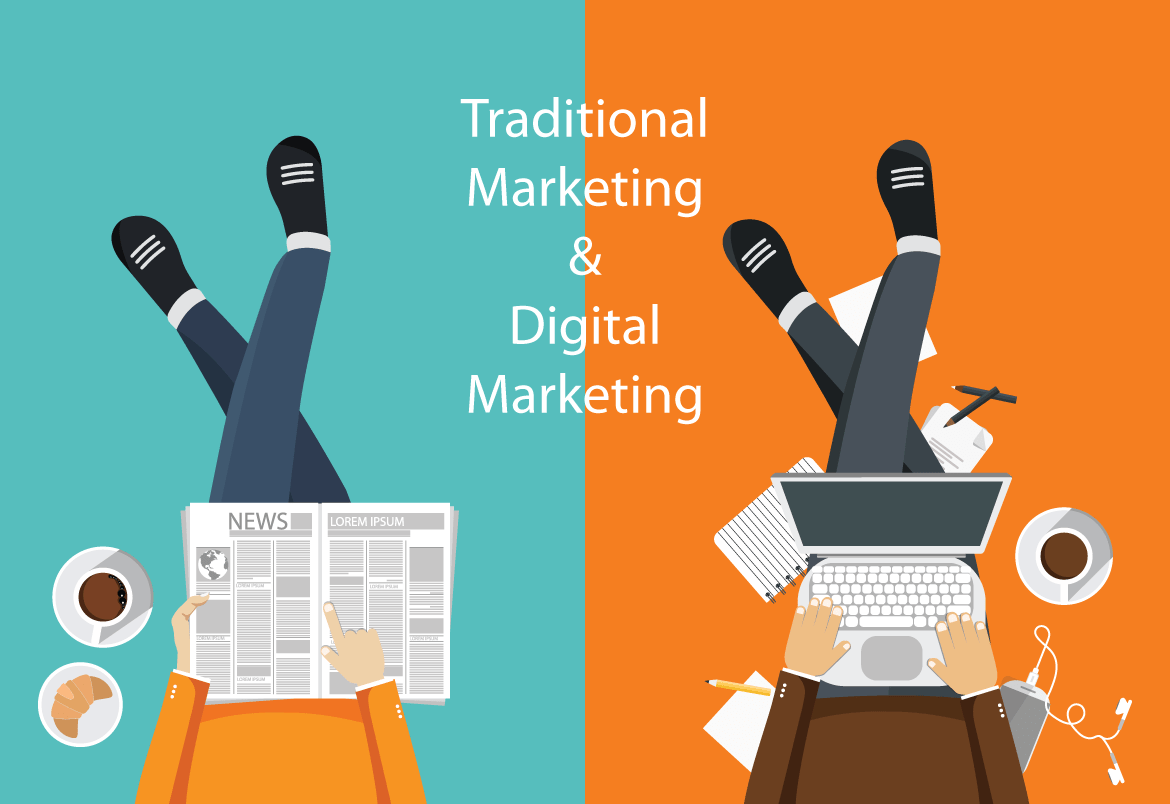
Traditional Marketing VS Digital Marketing
In 1998 Google entered the game, Microsoft launched the MSN search engine, and Yahoo introduced Yahoo web search to the market. Two years later, the internet became more widespread, and those lesser-known search engines stayed in the forgotten corners of the internet. The industry gave its first big surge in 2006 when search engine traffic grew by 6,4 billion in a single month.
Nevertheless, everything became more manageable for marketers when web 2.0 allowed users to interact with other users, but most importantly, with businesses. During this era, we saw the surge of the first social media platforms with MySpace. Still, everything became more feasible when Mark Zuckerberg saw marketing potential in its platform Facebook, and so, the digital marketing era as we know it began.
Check out "The Social Media Marketing History."
What is digital marketing?
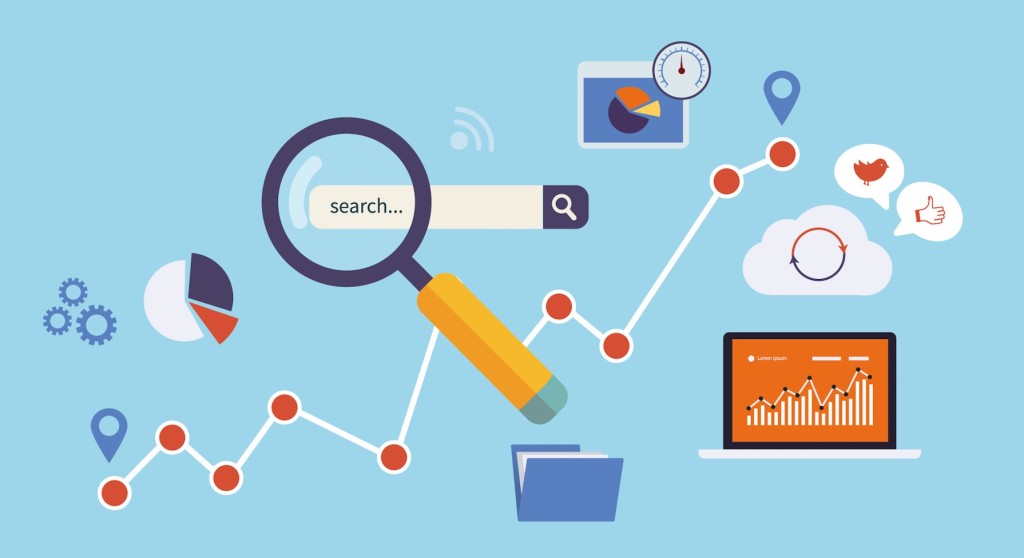
What is digital marketing?
Digital marketing involves online technologies such as digital media and different digital marketing channels to promote products and services. During COVID, people and brands realized that a global health problem couldn't stop our consuming and buying behaviours. So, trends like QCommerce, eCommerce, or any AI experience were the engines that kept digital marketing alive during that time. According to Statista, U.S. consumer making most of their purchases online grew by 129% until August 2020, and the most bought categories were household supplies (129%), snacks (113%) and personal care products (89%).
Focus well on your digital marketing funnel.
According to HubSpot, 96% of consumers know more about a brand online. We can back this up as an international digital agency with clients worldwide. With this change in consumer behavior, it has become more critical to focus on the digital strategy to promote brands and connect with potential customers using the internet and other forms of digital communication. You would be surprised to know that text and multimedia messages are marketing channels like e-mail, SEO, social media, and web-based advertising. Read this guide on PPC campaign strategy.
You could work with us, the leading digital marketing agency, to assist you in digital marketing.
There are three types of digital media:
- Earned Media
- Owned Media
- Paid Media
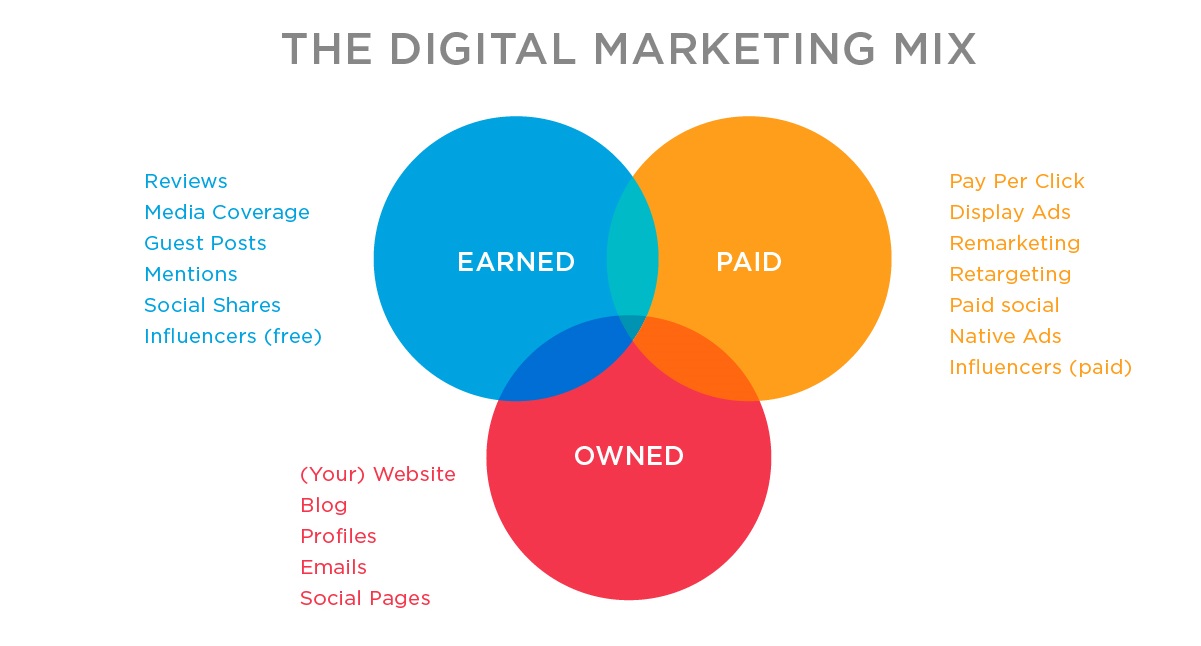
Earned Owned and Paid Media
Earned Media
Earned media is the publicity a company gets through word of mouth in the online environment.
As earned media is the organic reach, it becomes one of the most critical media forms for brands. As people talk about the brands themselves, there is a huge opportunity for better visibility and customer loyalty.
Owned Media
Owned media is the form of digital media that a company holds forever.
These marketing channels are crucial for engaging the users and lead nurturing. Website content, blogs, social media pages, videos, YouTube channels, etc., which the company controls with its name, are the forms of owned media.
Paid Media
Paid media constitutes the reach a brand gains with payments.
As organic reach takes time and is sometimes limited, brands use paid media to reach more audiences and create brand awareness or lead generation. Therefore, paid media is one of the most effective marketing channels to promote your brand on the web, and good campaigns on the proper channels can bring outstanding results.
What are the types of Digital Marketing?
The benefit of digital marketing is that it has a vast range of strategies to reach and engage with your audience. Depending on your business goals, you can adapt any of these to accomplish them. Let's take a closer look at each of these.
Content Marketing.
Unlike traditional marketing, you must constantly make content in digital marketing to keep audiences interested in your business and niche. For this goal, content marketing offers informational and valuable content that could answer your audience's questions or generate more engagement with interesting topics.
This type of content must be regularly posted because, on the internet, things lose relevancy quickly, and you have to be up to date with any news or trends in your business area.
As you create content, your audience will perceive you as a trusted voice in your area, gaining their fidelity with time. The idea is that customers perceive you as their first source when any question or need arises.
Pros
- It's free of cost.
- It's a versatile option to keep your audience informed, entertained, and inspired.
-
It is one of the bases of your digital marketing. Take
our blog, for example, where we constantly share valuable information on digital marketing topics.
Cons
- Due to its free cost, almost anybody can create content. Nevertheless, not all content on the web is truthful, and there's much misinformation on many vital topics.
- It can take much work to rank organically for target keywords.
- If you aren't persistent, your content will lose relevancy and audience. It's constant work, but achieving business goals is worth it.
Types of Content Marketing.
- Blogs.
- Videos.
- Podcasts.
- Social media posts.
- Tutorials.
- Guides.
- Infographics.
- Downloadable PDF.
Search Engine Optimization (SEO).
This strategy goes with the hand of Content Marketing, and it's because it aims to create content that search engines, like Google, like, and so it puts your website on the search engine results page.
Search engines use algorithms to decide how relevant your page is for any keyword you choose. These have constant updates, so marketers like us have to adjust their tactics to remain effective constantly.
This organic strategy can generate a tremendous increase in your website traffic when it's done correctly.
Pros
- SEO increases your brand's visibility.
- It is cost-efficient when compared to pay-per-click.
Cons
- It depends on your content quality and engagement.
-
Google's algorithm can be pretty hard to figure out. To learn more about it, read.
"The Definition of Algorithm: How can you use it for your social media strategy?." - It takes time to see results.
Pay-per-Click.
Better known as PPC, this is the paid version of SEO, where you pay to get your ads shown at the top of the search engine pages. When you apply this strategy, your ads will show in these slots with an "Ad" label next to your URL. As its name suggests, you only pay for your ad every time a user clicks on it.
Pros
- You can take your brand to a broader audience.
- It's a quick way to obtain a top rank.
- It's time efficient.
Cons
- If you want to rank for target popular keywords, it can be expensive.
Affiliate and Influencer Marketing.
When you work with an influencer, you can increase your reach by taking your brand to its big audience. This strategy aims to work with people with a decent following, and people consider them as authorities in your niche. Their followers will be open to trying or following your brand when you align with them.
Pros
- You can take advantage of the influencer's existing audience, increasing your follower number and raising their chances to convert.
- It's good for newer brands that want to create brand awareness.
Cons
-
With the high popularity among influencers, some scammers or unprofessional ones could ruin a partnership with your brand. If you want guidance on how to choose the right influencer,
we can help figure this out.
E-mail Marketing.
E-mail was one of the first digital tools that allowed users and brands to interact, and still, today keeps getting good results for brands. So, if you want to start an e-mail campaign, invite any website visitor to join your subscriber list to send them to content about sales, special events or offers.
This strategy works well to keep your audience engaged, so they don't forget about your business. The trick is to send valuable content marketing that keeps them updated with everything that's happening with your business.
Lyfe Marketing says that for every dollar spent on e-mail marketing, you get $40 approximately in revenue.
Pros
- Unlike the other strategies, e-mail marketing doesn't have to deal with changing algorithms. It's immune to it!
- Stay in contact with your e-mail list helps you strengthen customer relationships, making them more loyal to your brand.
Cons
- Sometimes customers don't check their e-mails.
- With time it gets challenging to generate relevant content that they like so they can unsubscribe from your list.
Mobile Marketing.
With smartphones getting smarter every day, today, we can do everything from our phones, so mobile marketing has become a top digital marketing strategy. Smartphones have made our lives so much easier that even by asking Alexa to find anything, we'll get it in a matter of seconds. Google research backs this up, informing that the use of this mobile function increased by 27% worldwide. Check our guide on Voice Search Optimization.
So, it becomes critical to fulfilling consumers' needs to access all our marketing channels through their phones. This means adding all your desktop platforms into a mobile-friendly version while entering into in-app advertising, texting, and social messaging apps.
Pros
- Today people spend more time on their phones than on their desktops or laptops, so it's a great place to reach them.
- You can use strategies like geo-fencing or specific audience segments.
Cons
- Mobile ads can have a low click rate.
- People can consider ads annoying while checking social media or talking on their phones.
Video Marketing.
We enter into one of the most effective types of content marketing. With the arrival of video platforms like TikTok, it has become crucial to have some sort of video content to stay engaged with people's short attention spam. Around social media platforms we see how everybody is desperate to get just one minute of their time and not to keep scrolling, so it becomes crucial to opt for this format.
80% of customers opt for videos to learn about a product while 55% of them research them before buying. We can add more by saying that over 2 billion people look for YouTube videos per month, so you may be losing a lot of chances by not trying video marketing.
Pros
-
Videos are excellent for storytelling, as you can generate an emotional connection with the masses if you create great videos.
Check this article to create captivating storytelling. - They're more memorable than blogs or photos and also easier to consume.
- All social media channels like Facebook, Instagram, Linkedin and TikTok are pushing video content to enhance engagement and reach so that you can rank higher in search results.
Cons
- With the "scrolling down syndrome," it gets harder to get people's attention with an immense amount of content. They can shift from your video to a meme in seconds.
- They take a lot of time to produce and edit. Also, it can cost you some money if you want to do it professionally.
The Pros and Cons of Digital Marketing
So, what are the pros and cons of digital marketing?
Pros:
- Digital marketing is highly customizable, so you can tailor your campaigns to reach your target audience.
- It's a great way to build customer relationships, as you can communicate with them directly through e-mail and social media channels.
- Digital marketing is a very cost-effective way to reach many people.
- It allows you to monitor your customer's data, from how many website visitors you have, how much percentage open your e-mails or what social media posts generate more engagement with your followers.
Cons:
- You need to have a strong online presence in order to be successful with digital marketing.
- Since it's more approachable for brands, there's high competition within social media and the internet.
- Customer attention spans are shorter online, so you need to be creative and engaging to hold their attention.
- Brands and users should be careful with their privacy online as some platforms have had issues in this aspect.
What is traditional marketing?

What is traditional marketing?
The significant difference between digital and traditional marketing is how an audience encounters the marketing message. And traditional marketing utilizes conventional media that includes magazines and newspapers, print, broadcast, telemarketing, or direct mail to engage the audience and broaden the reach.
What are the types of traditional media?
Traditional media generally includes all the non-digital advertising and marketing methods.
Traditional media is:
- Cold calling
- Door-to-door sales
- Banner ads
- Television advertisements
- Radio advertising
- Print advertising
- Direct mail advertisements
- Billboards and off-site signs
The Pros and Cons of Traditional Marketing
There are pros and cons to both traditional and digital marketing. Let's take a look at some of the key advantages and disadvantages of traditional marketing:
Advantages:
- Traditional marketing is very effective at reaching a large audience.
- It's a great way to build brand awareness and create top-of-mind awareness.
- It can help in local reach, especially when compared to digital marketing.
Disadvantages:
- It can be difficult to track the results of traditional marketing campaigns.
- It's often more time-consuming and labor-intensive than digital marketing.
- It can be difficult to keep up with the latest trends in traditional marketing.
- People tend to ignore commercials on the radio and TV as they are more interested on watching shows or news.
Advantages of digital marketing
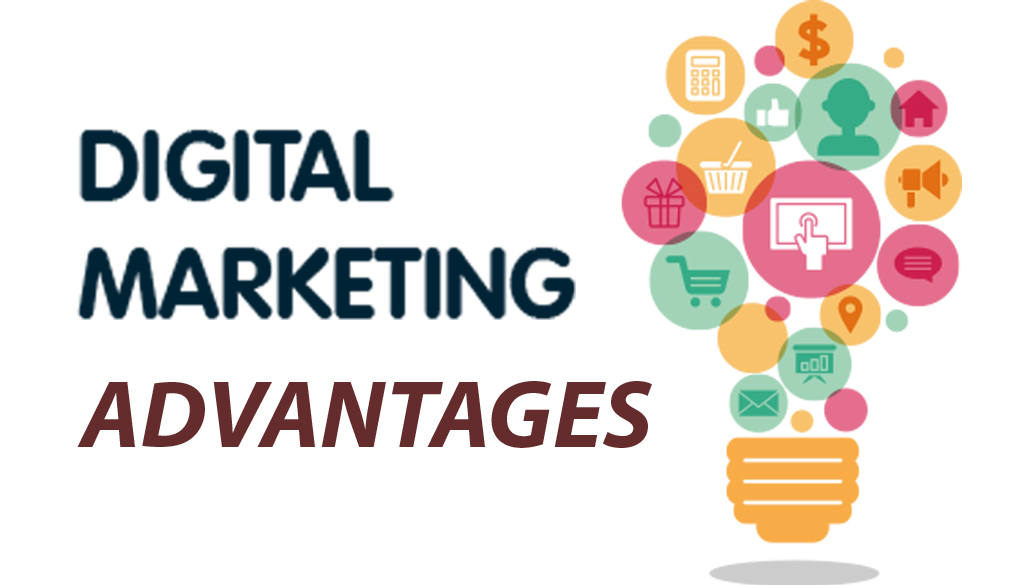
Advantages of digital marketing
Global reach
With digital marketing, any brand could reach new markets and trade globally; and track and measure the results. As of January 2021, there were 4.66 billion active internet users worldwide - 59.5 percent of the global population.
Of this total, 92.6 percent (4.32 billion) accessed the internet via mobile devices. With this tremendous reach, the wisest decision anybody could make is to invest in internet marketing channels.
Lower costs with a focus on ROI and ROAS
A properly planned digital marketing strategy allows you to target the customers who might be the right fit for your product. Not everybody on the internet is your customer. You could create a customer persona and target the people who fit this criterion.
Web analytics and other online metric tools make it very easy to measure your online marketing campaigns. It gives a clear idea of where the budget is spent and how much ROI (return on investment) and ROAS (return on advertising spend) could be obtained for every dollar spent.
The top-notch digital marketing agency like CodeDesign could help you get at least 3X to 4X return on your advertising budget. With the digitalization in marketing, the marketing budget is no more an expanse but an investment in the brand's growth.
You can measure results accurately.
When companies run digital campaigns, they have access to analytics, data that is gold to evaluate how your campaign did and what you could even improve.
From Google Analytics to the information provided by almost all social networks, you can have clear information on how your publications or running ads are doing and even make changes in real-time.
The analytics give information as accurate as from which sources you are receiving traffic, what type of audience is connecting with you the most, which are the channels that receive the most interaction among others, and even save you time on trial and error by telling you what the best times to publish on each channel are.
Higher conversion rates
While Television remained the most significant consumption media for 2021, with 165 minutes a day 2021, the combination of 130 minutes on mobile internet plus the 40 minutes of desktop screen time could outmatch the traditional marketing channel by 170 minutes—all this information found on Zenith's latest Media Consumption Forecast.
But what does this have to do with conversion rates?
When you watch something on TV, the customer's journey forces people to either go to the store or agency to convert or go to their computers and make the process much more straightforward.
As consumers spend more time on their digital devices, it makes it easier for them to buy as they can do everything with just a click, augmenting your chances to convert them.
Personalization
Not all customers are in the same stage of the marketing funnel. Thus, it makes excellent sense to provide personalized offers to each customer viewing your website or advertisement offer. However, it is impossible to add the personalization touch in traditional marketing, leading to weaker bonds between the brand and the customer.
However, with digital marketing, you could greet your audience with a personalized message in e-mail marketing and create different ad copies for people at different customer journey stages.
Advantages of traditional marketing
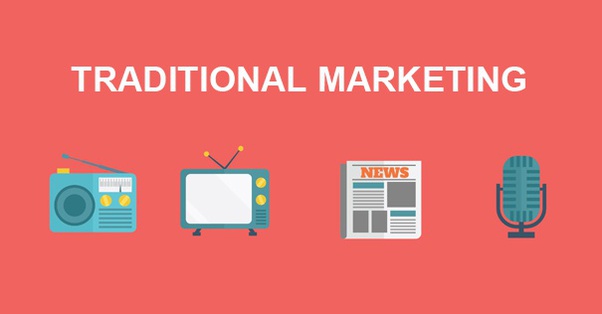
Advantages of traditional marketing
Local audience reach
The best part of traditional marketing is that it allows to reach the local audience and penetrate a local market. Traditional marketing also plays a vital role in getting the locals talking and interacting with them on the regional and daily basis. Today's marketing is more than exchanging products for money.
Instead, it is more about personal relationships between the brand and the consumer. Look, traditional marketing techniques like newspaper ads, commercials, local TV, or billboards significantly impact the local customers as the target audience feels more organic and less corporate.
Traditional marketing is tried and tested.
With the advent of digital marketing, many people wonder why traditional marketing are still around. If your product is best for an audience situated in the local area, then traditional marketing could have a higher success rate.
Billboards and TV advertisements are proven techniques to increase brand awareness and establish authority.
For example, a 15-minute show on Burj Khalifa could considerably enhance brand authority for the people who pass that area and online viewers if the brand pushed the same video online.
Hardcopy marketing are easier to process and recall
The attention span of people online is deficient. Thus it is evident that paper marketing could have the edge over digital media in recalling for people. In one report sponsored by a Canadian entity, it was apparent that paper marketing was more accessible for people to process and remember.
It means that people found it easier and more inclined to remember what they read in a printed advertisement than they did in a digital ad.
The Cost of Digital Marketing vs Traditional Marketing
Digital marketing is a form of marketing that uses digital technologies to reach and engage customers. This can include things like websites, e-mail campaigns, social media, and Paid Ads. Digital marketing is a great choice if you want to target a global audience, as it allows you to reach customers all over the world with minimal effort. As per WebFX, the average cost for digital marketing services in 2022 ranges from $2500 to $12,000 per month, $50 to $500+ per hour, and $1000 to $7500 per project for small-to-midsized businesses
Traditional marketing is the use of older methods like print ads, TV commercials, and direct mail to reach potential customers. It's a great option if you want to target a local audience, as it allows you to advertise your business in your local area. However, traditional marketing can be more expensive than digital marketing, and it's often less effective at reaching a global audience. As per HubSpot traditional marketing is much pricier. For instance, it can cost between $2,000-$160,000 to run a print ad. Further, you never know who you'll reach with that investment because results are difficult to measure.
Digital Marketing VS Traditional Marketing
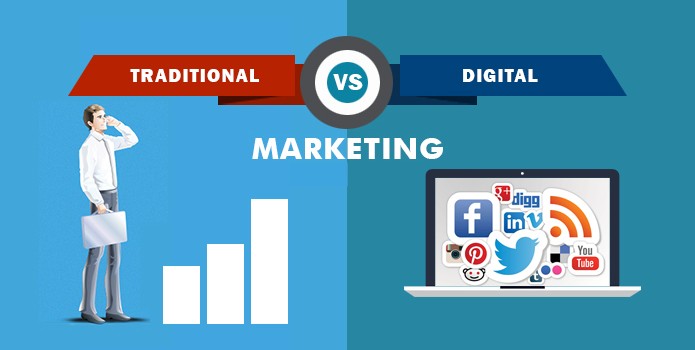
Digital Marketing Vs Traditional Marketing
Traditional marketing is static, whereas digital marketing is dynamic.
In digital marketing, you could specify the exact audience to who you want to show the ad. At the same time, you get to schedule small budgets for testing and have enough resources for A/B testing. You may also change the ad copy, budget, audience, etc., even when the ad is live. In contrast, you have no control over your target audience in a traditional marketing strategy.
The internet advertising industry is going crazy with such an immense shift of customer attention towards digital media.
Traditional Marketing is a one-way communication channel as people cannot send messages to the brand. In contrast, digital marketing allows people to send messages to the brand through comments on the advertisement, direct statements or responding to the chatbots.
Do you remember infomercials?
Those TV commercials are almost a "meme" nowadays, and many marketers criticize their simplicity.
Since traditional marketing puts a great wall between consumers and "The Brand," there's no much chance of giving a glimpse of what the product is all about. Infomercials always showed up "real people" - with awkward smiles and an acting that doesn't look so... credible - talking wonders about the product.
After this, not many real customers can give an honest opinion about the product unless you go deeper into reviews to check if the product actually works.
Now, with digital marketing, due to its instant communication, comments can jump right into a product's post, and with this, there's no hiding for product reviews.
This puts the responsibility on brands to offer a good product to audiences and, more, to build a closer relationship with those customers, creating stronger bonds with them.
Traditional Marketing tells, and Digital Marketing gives.
Traditional marketing is that old-school marketing schema where you only could persuade consumers through telling,
It's like the infomercials example: You tell people how wonderful it's, give vague examples and hope it will persuade your audience.
Of course, there are other formats or creative ideas to make people buy from traditional marketing. However, the great wall separating "The Brand" and consumers still makes the relationship distant.
Now, since digital marketing channels are more direct with audiences, it allows businesses to actually give some glimpses or a little taste of how good their products are or why they need services.
An insurance company can tell you in a 30 seconds TV spot why you need one of these, but this time is so short to explain why you need it.
Now, if this insurance company had a content marketing strategy, they could give you a more detailed explanation of why you need their services, what the benefits are, and the list of topics to explain goes on. Why? Because customers can directly ask that missing frequently asked questions, you can touch more on these topics.
Even more, if you sell products, a "how to use it?" video or a "tutorial" can demonstrate your product's capabilities, incrementing the buying wishes of all your customers.
Digital Marketing is shareable.
At the end of every YouTuber's video, we see how these creators emphasize commenting, subscribing and SHARING.
Digital marketing has this feature over traditional, and thanks to content marketing has more chances to go viral.
The most famous Superbowl spots debuted on the big game. Then people repeat them on Super Bowl compilations, which shows how this type of traditional marketing still needs digital strategies to keep being relevant in consumers' minds.
Meanwhile, users can share your content with a broader audience through all channels: Social media platforms and YouTube.
Traditional marketing can reach a larger audience, but this is more by imposition than a decision. Meanwhile, if more users share your content, you earn that expansion through your work, and in the end, they should share it for your merit than that it be transmitted to a large audience that is not necessarily interested in your product.
The constant repetition on TV, and even in digital ads like those on YouTube, can exhaust your audience. Therefore, earning that brand awareness that goes by word of mouth is a more sustainable way to grow.
Targeting an audience is standardized in traditional marketing, whereas it could be customized in the case of digital marketing.
Traditional marketing are costlier, and it is difficult to measure the results as there is no guarantee who would your ad reach. For example, a print ad could cost between $2000-$16,000, but specifying the people is impossible. However, you could run various versions of ads in digital marketing and test it on your customer persona to find the exact audience and ad copy that could bring the maximum return on investment.
Many local businesses still rely on traditional marketing for business operations and lead generations. However, the increase in popularity of digital marketing and a complete track on return on investment makes digital marketing a better option.
You could re-target your audience if they interacted with your ad but didn't perform the targeted action. You don't leverage such opportunities with traditional marketing. With the increase in competition and algorithm twerks, sometimes digital marketing become a bit painful and confusing. However, with the benefits that outweigh the cons, any brand could best invest in SEO agency and digital marketing to leverage the power of globalization and digitalization.
Traditional marketing is less effective and more expensive, but digital marketing is more effective and less costly.
The lack of features like selecting the audience to target or connecting with them with a personalized message at the preferred time makes traditional marketing less significant. Hence, many marketers agree that digital marketing has the edge over traditional marketing because of its increased effectiveness with the return on advertising spend and enhanced personalization.
Traditional media and digital media are competitive as most brands try their best to converse with their audience. In such a competitive atmosphere, personalization becomes the differentiating factor. As a result, personalized advertisements have at least 50% higher effectivity than non-personalized ones. And digital marketing gives you complete control over personalization.
The Impact of Digital Marketing vs Traditional Marketing
So, which is better: traditional marketing or digital marketing? The answer isn't so simple. Each type of marketing has its own unique benefits and drawbacks, and which one is right for your business will depend on your specific goals and needs.
Here's a breakdown of some of the key differences between traditional and digital marketing:
Traditional marketing tends to be more costly and time-consuming, but it can have a bigger impact on customers. Digital marketing is cheaper and more efficient, but it can be harder to be relevant in the minds of the people.
Traditional marketing relies heavily on advertising and PR, while digital marketing uses social media, e-mail marketing, and SEO to reach consumers.
Digital marketing is more tactile and personal, while traditional marketing is more impersonal but has a wider reach.
How to Decide Which Marketing Strategy Is Right for Your Business?
Making the decision to invest in marketing for your business is a big step, and it's important to choose the strategy that's right for you. So, how do you decide which is the right type of marketing for your business? Here are a few factors to consider:
Budget: Digital marketing is generally more affordable than traditional marketing, but it depends on what you're trying to achieve. If you want to reach a large audience, traditional marketing may be more expensive but more effective.
Audience: Digital marketing is great for reaching a wide audience, while traditional marketing is more effective at reaching a specific target market.
Purpose: Traditional marketing is generally used for branding and awareness, while digital marketing is more often used for sales and leads.
How Do I Decide?: Once you've considered these factors, the best way to decide is to try out both digital and traditional marketing and see which one works better for your business. If you are worried, we the CodeDesign team are here to help you find the right digital marketing channels for your business.
Why is CodeDesign regarded as the best digital marketing agency?
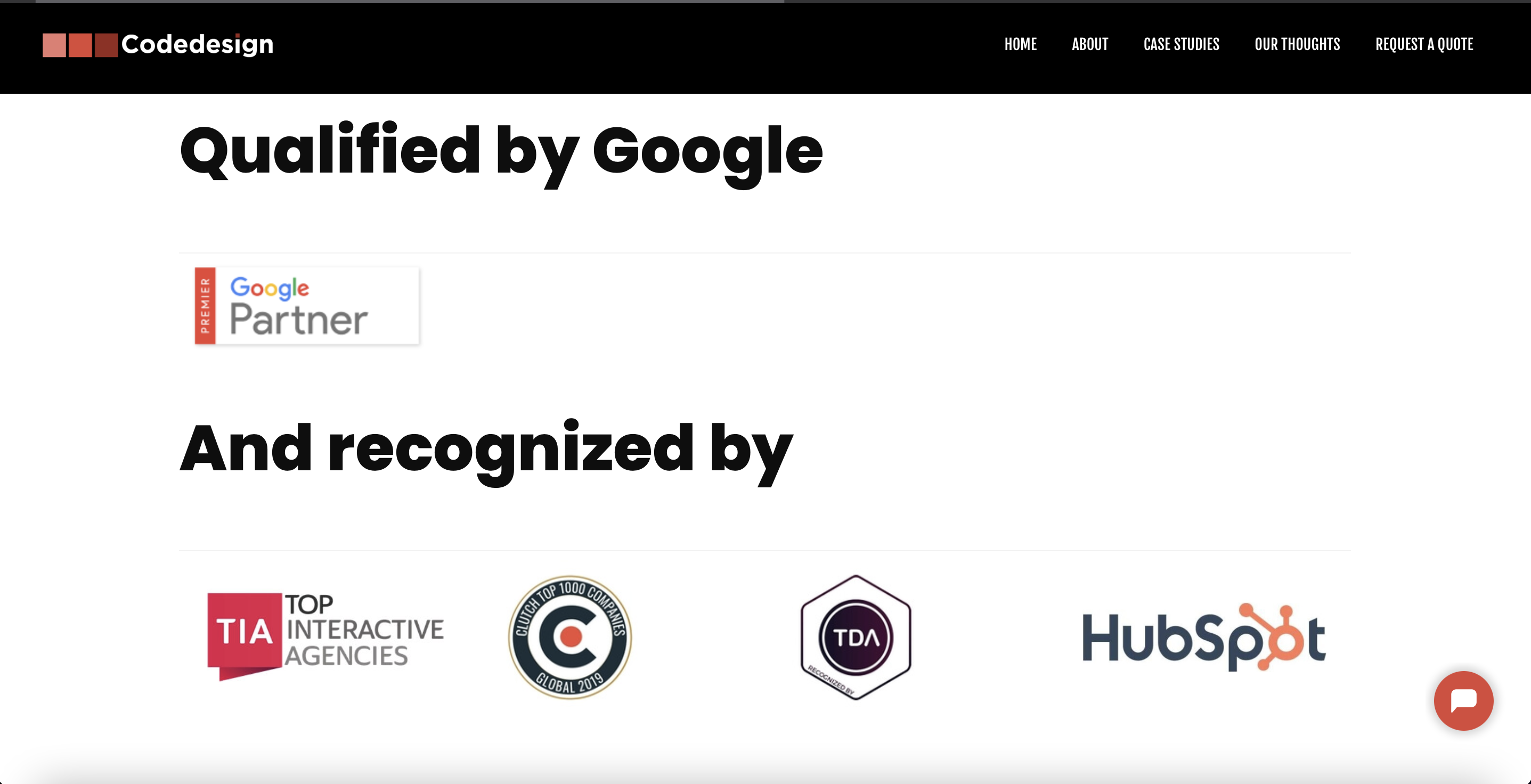
CodeDesign- Top Digital Marketing Agency
CodeDesign is a leading name in advertising industry. Our digital marketing experts have put together thousands of successful digital marketing campaigns for businesses looking to increase sales, leads, phone calls, transactions, and qualified website traffic.
The most crucial variable to track
We have an 86% client retention rate and a client recommendation score of 376% higher than the market average. We have a winning culture, a bespoke expert team that together are the perfect recipe for a successful digital presence.
Conclusion
There's no one-size-fits-all answer when it comes to deciding between traditional marketing and digital marketing. It all depends on your business and its specific needs.
However, here are some things to keep in mind when making your decision:
-Traditional marketing methods, such as print ads and TV commercials, can be expensive
-Digital marketing is often more targeted and efficient, meaning you can reach more of your target audience more quickly
-Traditional marketing methods can be slow to produce results, while digital marketing can show results almost immediately
So, which is right for your business? Only you can make that decision. But we hope this article has helped you make a more informed choice.
FREQUENTLY ASKED QUESTIONS:
1. Why digital marketing is becoming so different from traditional marketing?
Digital marketing is becoming so different from traditional marketing because it allows companies to target consumers where they are spending the majority of their time: online. Additionally, digital marketing provides a more cost-effective way to reach consumers than traditional marketing methods.
2. What is the difference between digital marketing and traditional marketing?
Digital marketing is the component of marketing that uses internet to market products or services. This includes the use of the internet, social media, mobile phones, and other digital devices. Traditional marketing is the use of more traditional methods to market products or services. This includes print ads, television commercials, and radio ads.
3. Will digital media replace traditional media?
This is a difficult question to answer. While digital media has already replaced traditional media in many ways, it is hard to say if it will completely replace traditional media. It is possible that digital media will continue to grow and eventually replace traditional media, but it is also possible that traditional media will continue to exist alongside digital media.
4. What are the uses of traditional marketing?
The uses of traditional marketing are to create awareness, interest, and desire for a product or service. It can also be used to build relationships with customers and create a brand identity. Traditional marketing can take many forms, including advertising, public relations, direct marketing, and sales promotions.
5. How to allocate budget for digital marketing?
The budget for digital marketing should be based on the company's overall marketing budget and objectives. The objectives should be specific, measurable, attainable, realistic, and time-based. A company's marketing budget is typically a percentage of the company's overall revenue. For example, if a company has a revenue goal of $1 million, its marketing budget could be 20% of that, or $200,000.

About Bruno GavinoBruno Gavino is the CEO and partner of Codedesign, a digital marketing agency with a strong international presence. Based in Lisbon, Portugal, with offices in Boston, Singapore, and Manchester (UK) Codedesign has been recognized as one of the top interactive agencies and eCommerce agencies. Awarded Top B2B Company in Europe and Top B2C company in retail, Codedesign aims to foster personal relationships with clients and create a positive work environment for its team. He emphasizes the need for digital agencies to focus on data optimization and performance to meet the increasingly results-driven demands of clients. His experience in digital marketing, combined with a unique background that includes engineering and data, contributes to his effective and multifaceted leadership style. |

About CodedesignCodedesign is a digital marketing agency with a strong multicultural and international presence, offering expert services in digital marketing. Our digital agency in Lisbon, Boston, and Manchester enables us to provide market-ready strategies that suit a wide range of clients across the globe (both B2B and B2C). We specialize in creating impactful online experiences, focusing on making your digital presence strong and efficient. Our approach is straightforward and effective, ensuring that every client receives a personalized service that truly meets their needs. Our digital agency is committed to using the latest data and technology to help your business stand out. Whether you're looking to increase your online visibility, connect better with your audience, get more leads, or grow your online sales. For more information, read our Digital Strategy Blog or to start your journey with us, please feel free to contact us. |
CodeDesign is leading:
- Digital Agency
- Digital Marketing Agency
- Digital Ecommerce Agency
- Amazon Marketing Agency



Add comment ×